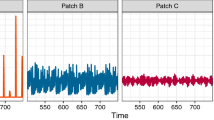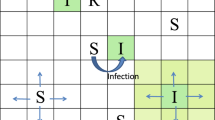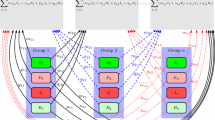Abstract
The effects of spatial movements of infected and susceptible individuals on disease dynamics is not well understood. Empirical studies on the spatial spread of disease and behaviour of infected individuals are few and theoretical studies may be useful to explore different scenarios. Hence due to lack of detail in empirical studies, theoretical models have become necessary tools in investigating the disease influence in host-pathogen systems.
In this paper we developed and analysed a spatially explicit model of two interacting social groups of animals of the same species. We investigated how the movement scenarios of susceptible and infected individuals together with the between-group contact parameter affect the survival rate of susceptible individuals in each group. This work can easily be applied to various host-pathogen systems.
We define bounds on the number of susceptibles which avoid infection once the disease has died out as a function of the initial conditions and other model parameters. For example, once disease has passed through the populations, a larger diffusion coefficient for each group can result in higher population levels when there is no between-group interaction but in lower levels when there is between-group interaction. Numerical simulations are used to demonstrate these bounds and behaviours and to describe the different outcomes in ecological terms.
Similar content being viewed by others
References
Anderson, R. M. and W. Trewhella (1985). Population dynamics of the badger (Meles meles) and epidemiology of bovine tuberculosis (Mycobacterium bovis). Philos. Trans. R. Soc. Lond. B 310, 327–381.
Artois, M. and M. F. A. Aubert (1985). Behaviour of rabid foxes. Rev. Ecol. (Terre Vie) 40, 171–176.
Bacon, P. J. (Ed.) (1985). Population Dynamics of Rabies in Wildlife, London: Academic Press.
Beardmore, I. and K. A. J. White (2001). Spreading disease through social groupings in competition. J. Theor. Biol. 212, 253–269.
Cheeseman, C. L. and P. J. Mallison (1982). Behaviour of badgers (Meles meles) infected with bovine tuberculosis. J. Zool. 194, 284–289.
Cliff, A. D. (1995). Incorporating spatial components into models of epidemic models, in Epidemic Models—their Structure and Relation to Data, D. Mollison (Ed.), Cambridge: Cambridge University Press, pp. 119–149.
Henry, D. (1981). Geometric Theory of Semilinear Parabolic Equations, Berlin: Springer.
Hudson, P. (1997). Ecological Issues: Wildlife Diseases, British Ecological Society.
Kaplan, C. (Ed.) (1977). Rabies: The Facts, Oxford: Oxford University Press.
Kermack, W. O. and A. G. McKendrick (1927). A contribution to the mathematical theory of epidemics. Proc. R. Soc. Lond. A 115, 700–721.
Lewis, M. A. and J. D. Murray (1993). Modelling territoriality and wold-deer interactions. Nature 366, 738–739.
Maynard Smith, J. and G. R. Price (1973). The logic of animal conflict. Nature 246, 15–18.
Mech, L. D. (1970). The Ecology and Behaviour of an Endangered Species, Garden City, NY: Natural History Press.
Murray, J. D. (1993). Mathematical Biology, Heidelberg: Springer.
Noble, J. V. (1974). Geographic and temporal development of plagues. Nature 250, 726–729.
Okubo, A. (1980). Diffusion and Ecological Problems: Mathematical Models, Berlin, Heidelberg: Springer.
Pao, C. V. (1992). Nonlinear Parabolic and Elliptic Equations, New York: Plenum Press.
White, K. A. J., M. A. Lewis and J. D. Murray (1996). A model of wolf-pack territory formation and maintenance. J. Theor. Biol. 178, 29–43.
Author information
Authors and Affiliations
Corresponding author
Rights and permissions
About this article
Cite this article
Gudelj, I., White, K.A.J. & Britton, N.F. The effects of spatial movement and group interactions on disease dynamics of social animals. Bull. Math. Biol. 66, 91–108 (2004). https://doi.org/10.1016/S0092-8240(03)00075-2
Received:
Accepted:
Issue Date:
DOI: https://doi.org/10.1016/S0092-8240(03)00075-2




